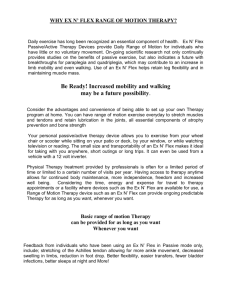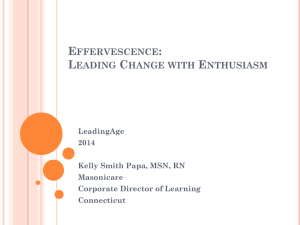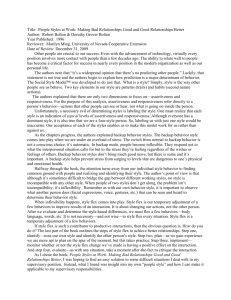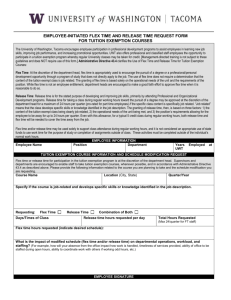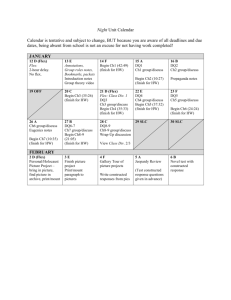High Freq Flex minutes_073015
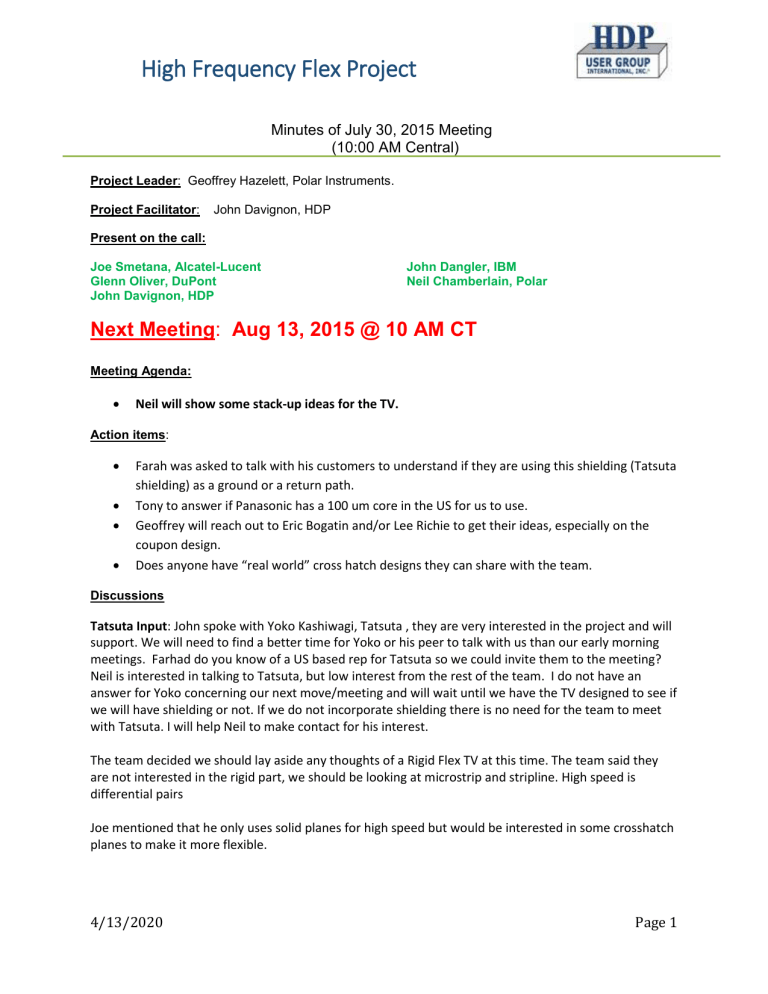
High Frequency Flex Project
Minutes of July 30, 2015 Meeting
(10:00 AM Central)
Project Leader : Geoffrey Hazelett, Polar Instruments.
Project Facilitator : John Davignon, HDP
Present on the call:
Joe Smetana, Alcatel-Lucent
Glenn Oliver, DuPont
John Davignon, HDP
John Dangler, IBM
Neil Chamberlain, Polar
Next Meeting
:
Aug 13, 2015 @ 10 AM CT
Meeting Agenda:
Neil will show some stack-up ideas for the TV.
Action items :
Farah was asked to talk with his customers to understand if they are using this shielding (Tatsuta shielding) as a ground or a return path.
Tony to answer if Panasonic has a 100 um core in the US for us to use.
Geoffrey will reach out to Eric Bogatin and/or Lee Richie to get their ideas, especially on the coupon design.
Does anyone have “real world” cross hatch designs they can share with the team.
Discussions
Tatsuta Input: John spoke with Yoko Kashiwagi, Tatsuta , they are very interested in the project and will support. We will need to find a better time for Yoko or his peer to talk with us than our early morning meetings. Farhad do you know of a US based rep for Tatsuta so we could invite them to the meeting?
Neil is interested in talking to Tatsuta, but low interest from the rest of the team. I do not have an answer for Yoko concerning our next move/meeting and will wait until we have the TV designed to see if we will have shielding or not. If we do not incorporate shielding there is no need for the team to meet with Tatsuta. I will help Neil to make contact for his interest.
The team decided we should lay aside any thoughts of a Rigid Flex TV at this time. The team said they are not interested in the rigid part, we should be looking at microstrip and stripline. High speed is differential pairs
Joe mentioned that he only uses solid planes for high speed but would be interested in some crosshatch planes to make it more flexible.
4/13/2020 Page 1
High Frequency Flex Project
We need to think about the copper profile we want for the return path/ground plane – (contact the
Smooth Cu Si project?)
Design/layout discussions with Glenn Oliver’s inputs below. I hope I captured these correctly, Neil will take this information or the notes that he took and put into some possible constructions for discussion at the next meeting.
microstrip:
2 layer flex,
50 um core
Line width 100-150 um wide traces
18um copper thickness
Coverlay; 1 mill adhesive & 1 mil of poly
Single ended 50 Ohm
For high speed we need a stripline:
Stripline
3 layer flex
100 um core
125 um bond-ply
Equal or 1.5 the line width spacing for differential pairs
100 Ohm differential
Cross hatch stripline:
3 layer flex
50 um coverlay
18 um copper
50 um poly core
18 um copper
125 bond-ply
18 um copper
50 um poly core
18 um copper
50 un coverlay
Tony to answer if Panasonic has a 100 um core in the US for us to use.
Shielding Discussions: The Tatsuta would be a coverlay of metal over the entire design, for EMF.
Controlled impedance is only a side benefit. This will affect the microstrip impedance, so we need to be aware of using this shielding in our impedance calculations.
Cross Hatch Designs discussions: The typical cross hatch design from Polar’s software are 45 degree lines crosshatched. 45 degree lines are not really good for flex since they make sharp points that stress risers, perhaps holes would be better instead. NOTE: only the 45 degree lines will give the same amount of grounding on both sides of the trace, this is only capable if you use 45 degree cross hatching.
Ratio of line pitch to hatch pitch needs to be explored. 1 -1.5-1.8 etc.
4/13/2020 Page 2
High Frequency Flex Project
Copper coverage is another variable to include
Need to have meeting to have what factors we want to explore in our DOE/Matrix.
Measurement discussion:
Impedance
Insertion loss and return loss
What method/coupons do we use for loss? SPP seems like the winner from the team response.
Should we put connectors on these and use a network analyzer? Glenn has a VNA tester and will measure for us.
Connectors take up a lot of space and limits the amount of coupons we can put on a board. We should use the TDR to do this now and down select some designs for later rebuild and VNA testing in a later phase 2 follow on.
Neil said that they can do the connectorless SPP testing.
This will show that we can use SPP for flex also.
We need someone to look at hatch patterns and which ones we may want to look at on the TV. This may be moving into the propriety area of some companies, but it would save us a lot of time if we could get some “real world” designs. Does anyone have one or two they can share?
Next Meeting : Aug 13, 2015 @ 10AM CT
EOM
4/13/2020 Page 3


